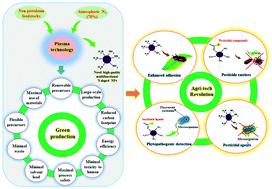当前位置:
X-MOL 学术
›
React. Chem. Eng.
›
论文详情
Our official English website, www.x-mol.net, welcomes your
feedback! (Note: you will need to create a separate account there.)
Perspectives on plasma-assisted synthesis of N-doped nanoparticles as nanopesticides for pest control in crops
Reaction Chemistry & Engineering ( IF 3.4 ) Pub Date : 2020-05-26 , DOI: 10.1039/d0re00069h Quoc Hue Pho 1, 2, 3, 4 , Dusan Losic 1, 2, 3, 4, 5 , Kostya (Ken) Ostrikov 4, 6, 7, 8 , Nam Nghiep Tran 1, 2, 3, 4, 9 , Volker Hessel 1, 2, 3, 4, 10
Reaction Chemistry & Engineering ( IF 3.4 ) Pub Date : 2020-05-26 , DOI: 10.1039/d0re00069h Quoc Hue Pho 1, 2, 3, 4 , Dusan Losic 1, 2, 3, 4, 5 , Kostya (Ken) Ostrikov 4, 6, 7, 8 , Nam Nghiep Tran 1, 2, 3, 4, 9 , Volker Hessel 1, 2, 3, 4, 10
Affiliation

|
To enhance crop efficiency and meet the growing global demands for food, a new agri-tech revolution has recently been triggering. Engineered nanomaterials have the potential of lessening environmental impact and making agriculture more efficient, resilient, and sustainable. Nitrogen-doped nanoparticles (N-doped NPs) are a rising star toward the development of a new generation of nanopesticides for advanced green agriculture, providing improved efficiency, new concepts for pest control and reduced pesticide resistance, which are key limitations of conventional pesticides. The objectives of this paper are (1) to provide perspectives of promising applications of N-doped NPs as emerging nanopesticides and (2) to review the opportunities which plasma-enabled NP technology is offering for the scalable production of N-doped NPs based on a green, eco-friendly and sustainable approach. The main advantages of the N-doped NPs are their multifunctionality enabling them to provide enhanced adhesion to leaves or insect bodies and several different modes of action to kill insects, including physical, biochemical and catalytic, that are expected to considerably reduce the insect population. Apart from insects, these nanomaterials can inactivate phytopathogenic bacteria and fungi through various mechanisms and are therefore used for a broad spectrum of plant protection. In this review, N-doped ZnO and N-doped TiO2 NPs will be introduced and reviewed as the first examples of these nanomaterials that have been successfully proven as nanopesticides. Following the first demonstration and the application of N-doped carbon dots (N-doped CDs), various agricultural applications such as nanopesticides, pesticide nanocarriers, disease detection, and pest targeting will be reviewed showing their enormous potential to be translated into real applications. The plasma technology comes into play when the focus is on the manufacturing process of these nanomaterials, since, in pest control, producing high-quality nanopesticides is indispensable and challenging. Plasma-chemical NP processing is a green, simple, and rapid approach compared to conventional methods and this review presents how this technology can be used to produce N-doped NPs in a high-quality, high-quantity, low-cost, energy-efficient and sustainable way with minimal waste and without the use of toxic chemicals. The implementation of this technology and introduction of N-doped NPs as new powerful pesticidal agents could make a significant impact on improved crop production.
中文翻译:

等离子体辅助合成N掺杂纳米颗粒作为农药用于农作物病虫害防治的观点
为了提高作物效率并满足全球对食品日益增长的需求,最近引发了一场新的农业技术革命。工程纳米材料具有减轻环境影响并提高农业效率,弹性和可持续性的潜力。氮掺杂的纳米颗粒(N掺杂的NPs)是用于先进绿色农业的新一代纳米农药的发展的后起之秀,这种农药具有更高的效率,新的虫害控制概念和降低的农药抗性,这是常规农药的主要局限性。本文的目的是(1)提供前景广阔的N掺杂NP作为新兴的纳米农药的应用前景(2)回顾基于等离子体的NP技术为基于N的NP的可扩展生产提供的机会。绿色 生态友好和可持续的方法。N掺杂NP的主要优点是它们的多功能性,使它们能够增强对叶片或昆虫体的附着力,并具有多种杀死昆虫的不同作用方式,包括物理,生化和催化作用,有望大大减少昆虫的数量。除昆虫外,这些纳米材料还可以通过多种机制灭活植物致病性细菌和真菌,因此被广泛用于植物保护。在这篇评论中,N掺杂的ZnO和N掺杂的TiO 有望大大减少昆虫的数量。除昆虫外,这些纳米材料还可以通过多种机制灭活植物致病性细菌和真菌,因此被广泛用于植物保护。在这篇评论中,N掺杂的ZnO和N掺杂的TiO 有望大大减少昆虫的数量。除昆虫外,这些纳米材料还可以通过多种机制灭活植物致病性细菌和真菌,因此被广泛用于植物保护。在这篇评论中,N掺杂的ZnO和N掺杂的TiO2NPs将作为已成功证明为纳米农药的这些纳米材料的第一个实例进行介绍和审查。在首次展示和应用N掺杂碳点(N掺杂CD)之后,将审查各种农业应用,例如纳米农药,农药纳米载体,疾病检测和病虫害靶向,显示其巨大的潜力可以转化为实际应用。当重点关注这些纳米材料的制造过程时,等离子体技术就发挥了作用,因为在有害生物控制中,生产高质量的纳米农药是必不可少的且具有挑战性的。与常规方法相比,等离子体化学NP处理是一种绿色,简单且快速的方法,本综述介绍了如何将该技术用于生产高质量,高数量的N掺杂NP,低成本,节能和可持续发展的方式,浪费最少,并且不使用有毒化学物质。这项技术的实施和引入N掺杂的NP作为新型强大的杀虫剂可能会对改善作物产量产生重大影响。
更新日期:2020-07-28
中文翻译:

等离子体辅助合成N掺杂纳米颗粒作为农药用于农作物病虫害防治的观点
为了提高作物效率并满足全球对食品日益增长的需求,最近引发了一场新的农业技术革命。工程纳米材料具有减轻环境影响并提高农业效率,弹性和可持续性的潜力。氮掺杂的纳米颗粒(N掺杂的NPs)是用于先进绿色农业的新一代纳米农药的发展的后起之秀,这种农药具有更高的效率,新的虫害控制概念和降低的农药抗性,这是常规农药的主要局限性。本文的目的是(1)提供前景广阔的N掺杂NP作为新兴的纳米农药的应用前景(2)回顾基于等离子体的NP技术为基于N的NP的可扩展生产提供的机会。绿色 生态友好和可持续的方法。N掺杂NP的主要优点是它们的多功能性,使它们能够增强对叶片或昆虫体的附着力,并具有多种杀死昆虫的不同作用方式,包括物理,生化和催化作用,有望大大减少昆虫的数量。除昆虫外,这些纳米材料还可以通过多种机制灭活植物致病性细菌和真菌,因此被广泛用于植物保护。在这篇评论中,N掺杂的ZnO和N掺杂的TiO 有望大大减少昆虫的数量。除昆虫外,这些纳米材料还可以通过多种机制灭活植物致病性细菌和真菌,因此被广泛用于植物保护。在这篇评论中,N掺杂的ZnO和N掺杂的TiO 有望大大减少昆虫的数量。除昆虫外,这些纳米材料还可以通过多种机制灭活植物致病性细菌和真菌,因此被广泛用于植物保护。在这篇评论中,N掺杂的ZnO和N掺杂的TiO2NPs将作为已成功证明为纳米农药的这些纳米材料的第一个实例进行介绍和审查。在首次展示和应用N掺杂碳点(N掺杂CD)之后,将审查各种农业应用,例如纳米农药,农药纳米载体,疾病检测和病虫害靶向,显示其巨大的潜力可以转化为实际应用。当重点关注这些纳米材料的制造过程时,等离子体技术就发挥了作用,因为在有害生物控制中,生产高质量的纳米农药是必不可少的且具有挑战性的。与常规方法相比,等离子体化学NP处理是一种绿色,简单且快速的方法,本综述介绍了如何将该技术用于生产高质量,高数量的N掺杂NP,低成本,节能和可持续发展的方式,浪费最少,并且不使用有毒化学物质。这项技术的实施和引入N掺杂的NP作为新型强大的杀虫剂可能会对改善作物产量产生重大影响。











































 京公网安备 11010802027423号
京公网安备 11010802027423号